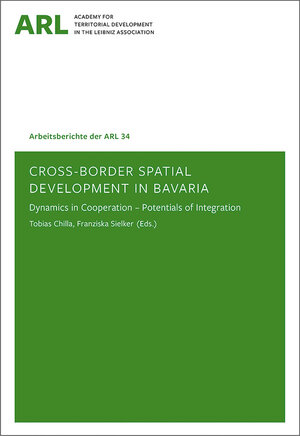Cross-border spatial development in Bavaria
Dynamics in Cooperation – Potentials of Integration.
herausgegeben von Tobias Chilla und Franziska SielkerThere are a number of reasons for considering the cross-border dimension of
Bavaria’s spatial development at the present time. First, there is a new awareness of
cross-border development issues on the level of the federal state of Bavaria. This is
particularly related to the border between Bavaria and the Czech Republic, which
is so historically and politically complex that it has long been difficult to address on
the Prague-Munich diplomatic level. Tangible developments have recently been
seen here on the ‘middle level’. At the same time the start of the macro-regional
strategy EUSALP has led to increased discussion of spatial development instruments
in the Alpine region.
Second, the significance of borders was placed on the political agenda with unexpected
force by the flows of refugees that largely began in 2015. After many years of
widespread talk of a ‘borderless’ Europe, debates about refugee policies and border
controls have made clear that the internal European borders still have considerable
political significance. In Bavaria this mainly affects its border region with Austria.
Third, a new impetus in cross-border cooperation on the European level can be identified:
in recent years the focus was on activities in the immediate border area based
on INTERREG-A and Euroregions. These remain important, but there is also a new
impetus on the higher level, where macro-regions and numerous bilateral and multilateral
forms of cooperation are creating new constellations. In Bavaria this can be
seen particularly in the relatively new European Region of Danube-Vltava and through
involvement in the Danube and Alpine macro-regions
Bavaria’s spatial development at the present time. First, there is a new awareness of
cross-border development issues on the level of the federal state of Bavaria. This is
particularly related to the border between Bavaria and the Czech Republic, which
is so historically and politically complex that it has long been difficult to address on
the Prague-Munich diplomatic level. Tangible developments have recently been
seen here on the ‘middle level’. At the same time the start of the macro-regional
strategy EUSALP has led to increased discussion of spatial development instruments
in the Alpine region.
Second, the significance of borders was placed on the political agenda with unexpected
force by the flows of refugees that largely began in 2015. After many years of
widespread talk of a ‘borderless’ Europe, debates about refugee policies and border
controls have made clear that the internal European borders still have considerable
political significance. In Bavaria this mainly affects its border region with Austria.
Third, a new impetus in cross-border cooperation on the European level can be identified:
in recent years the focus was on activities in the immediate border area based
on INTERREG-A and Euroregions. These remain important, but there is also a new
impetus on the higher level, where macro-regions and numerous bilateral and multilateral
forms of cooperation are creating new constellations. In Bavaria this can be
seen particularly in the relatively new European Region of Danube-Vltava and through
involvement in the Danube and Alpine macro-regions






